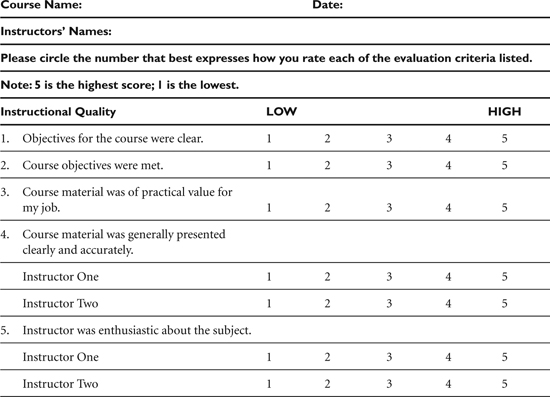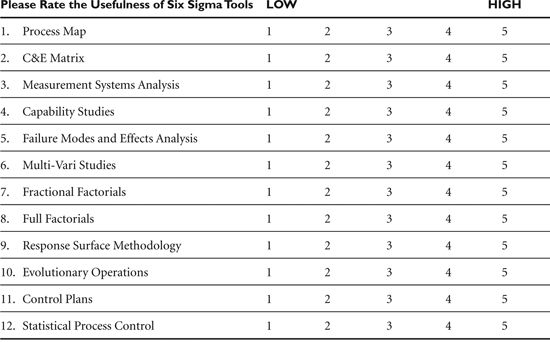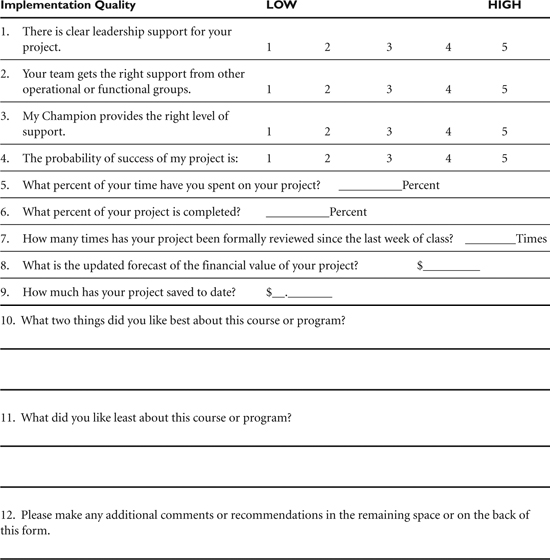11. Selecting and Training the Right People
An integral stage in driving large-scale change is building the guiding coalition. This is the second stage of John Kotter’s eight stages for leading change protocol covered in detail in Chapter 3, “Six Sigma Launch Philosophy.” Kotter asserts that the people within the guiding coalitions must have strong positional power, broad expertise, and high credibility.
Extensive training in Six Sigma is important because the guiding team should have the capability to lead Six Sigma and the technical expertise to understand and use Six Sigma. These factors add up to credibility in driving Six Sigma. In addition, a supporting infrastructure for the coalition must exist with well-defined processes. One of the infrastructure processes is guiding ongoing Six Sigma training, because training, if done right, empowers your people to take action via process improvement projects.
Six Sigma deployments present the two challenges of launching new methods of process improvement, new organizational structures, and new positions to lead the program. Training is the success factor in any Six Sigma deployment. Training supports Kotter’s stage, “Empowering employees to broad-based action.”
The leadership team in AlliedSignal received substantial training in Six Sigma. I recall holding several one-on-one training sessions with the CEO during the early days of deployment. This chapter will present some common training agendas for your review. Chapter 8, “Defining the Six Sigma Infrastructure,” when discussing the Six Sigma infrastructure, carefully covered the selection and the roles of the deployment team members plus a summary of the training for each position.
The Six Sigma training accomplishes several actions simultaneously. The training provides students with the technical knowledge of Six Sigma. By training everyone on the deployment team, the team starts learning how to work together as a team. We want to start the deployment with the right people, and training will help determine who might be the right people and provides the right people a common ground upon which to stand. This chapter addresses selecting and training the right people for the right positions. The training we discuss in this chapter includes the following:
• Master Black Belts
• Black Belts
• Green Belts
The training for the following positions
• Initiative, Deployment, and Project Champs
• Financial Resources
• Human Resources
has been covered in Chapters 8 and 10 already and will not be reviewed in this chapter.
Each person in each one of these positions must have leadership capabilities and personal motivation to effectively change the culture. Each deployment team member has a role common with the others. They each must
• Communicate Six Sigma initiative.
• Set aggressive goals and drive implementation.
• Develop and implement the improvement strategy.
• Track and report impact of the change initiative.
• Break down business barriers.
• Create supporting systems.
• Develop performance databases.
• Have internal Six Sigma technical expertise.
• Celebrate successes.
Six Sigma training events are customized for each company deploying Six Sigma. There is not a turnkey set of customized training material. Once the Executive Team has clarified where Six Sigma fits strategically, the training program is designed to meet those expectations. My consulting company has a huge training portfolio, but no client has deployed every course during the deployment. And the courses they did deploy were customized to reflect their company’s industry, markets, and strength and weaknesses. Let’s take a look at the broad portfolio of Six Sigma training courses.
Six Sigma, Lean Sigma, and Lean Training Portfolio—Enterprise Wide
We will now review a portfolio of training programs for both Six Sigma and Lean both separately and integrated. These programs cover the spectrum from relatively shorter and less technical leadership workshops to lengthy and highly technical “Belt” training and some methodological specialties such as demand forecasting.
The Six Sigma Steering Team has the opportunity to move Six Sigma training literally into every part of the company. But, as in project selection, prioritizing the Six Sigma training targets and goals should be done within the first 90 days and the plan executed accordingly. The bulk of the training will be aimed toward Black Belts and Green Belts. Specialized training aimed at specific functions (e.g., Supply Chain Management) will also be added to the deployment plan when it fits strategically. The seven categories we will investigate include the following:
1. Leadership Workshops
2. Business and operational assessments
3. Value creation and management
4. Operational processes
5. Business (transactional) processes
6. Lean methods
7. Master Black Belt
Training Portfolios: Six Sigma, Lean Sigma, and Lean Training
1. Leadership Workshops and Participants

2. Business and Operational Assessments—Asset Maximization
• Business Assessment
• Operations Assessment
• Existing Technology Assessment
• Transactional/Business Process Assessment
3. Value Creation and Management: Design for Six Sigma (DFSS)

4. Operational Processes and Participants
• Operational Assessment (Leadership, Champions)
• Six Sigma in Assembled Products, Chemical Products (Black Belts, Green Belts)
• Lean Sigma (Black Belts, Green Belts)
• K-Sigma™ (Black Belts)
• Analytical GB (Laboratory Green Belts)
• Asset Dependability (Equipment Reliability Green Belts)
• Supply Chain GB (Supply Chain Black Belts and Green Belts)
• Demand Forecasting Workshop (Supply Chain Leadership)
• Environmental, Health, and Safety (EHS) (EHS Black Belts and Green Belts)
5. Business (Transactional) Processes and Participants
• Transactional Overview (Leadership, Champions)
• Transactional Green Belt
• Six Sigma Process Design (SSPD) (Functional Leadership, Green Belts)
• Transactional Black Belts
• Transactional Kaizen (Black Belts, Green Belts)
6. Lean Methods and Participants
• Lean—Manufacturing (Black Belts, Green Belts)
• Lean and Six Sigma (Black Belts, Green Belts)
• Lean—Transactional (Green Belts)
• Lean Deployment Approach
• Kaizen
• Lean Leader (Lean Leaders)
• Lean Design (Black Belts, Green Belts)
7. Master Black Belt
Six Sigma and Lean
Many companies deploy Six Sigma and Lean Enterprise initiatives separately. The current trend is to launch both simultaneously to quickly gain the advantages of both technologies. Very simply, Lean addresses business speed and Six Sigma addresses process stability and accuracy. Lean focuses on removing waste in process, leaving only value-added activity. Six Sigma removes variability within any process. Six Sigma and Lean, when integrated, provide the most powerful method of reinventing a business.
When Six Sigma?
• Process inputs are variable: suppliers, raw materials, capabilities.
• Process outcomes are not predictable: purity, specs, timing.
• We are creating a new product or process (inventing).
• Quality of internal and/or external products are suspect.
When Lean?
• Our lead time is too long.
• We are “reacting” to problems.
• Supplier alignment: inventories unstable or slow.
• Customer alignment: impact buys caused by short horizons.
• Inventory levels fluctuate, causing excess overtime, delays.
• Floor space, inventories, flows are not optimal.
• Resources: equipment, people, facilities, cash is not optimal.
By integrating Lean with Six Sigma, we attack multiple business performance gaps simultaneously. The training in both really doesn’t take much longer than training for both individually.
Leadership Workshops
The leadership training has already been overviewed in Chapter 10, “Creating Six Sigma Executive and Leadership Workshops.” These workshops are implemented at the very beginning of Six Sigma. The order of events usually follows this pattern:
• Strategic Planning (Executive Team)
• Executive Overview (Executive Team)
• Business Team Workshop (Business Team)
• Champion Workshop (Initiative, Deployment, and Project Champions)
• Site/Functional Leadership Workshop (Site or Functional Leadership)
• Leadership Green Belt (Initiative, Deployment, and Project Champions)
Recommended Leadership Training
• Executive Steering Team
• Executive Overview
• Division Leadership
• Executive Overview
• Business Team Workshop
• Executive Overview
• Business Team Overview
• Full or Leadership Green Belt with Project
• Site Team Leadership
• Site Team Overview
• Full or Leadership Green Belt with Project
• Initiative, Deployment, and Project Champions
• Champion Training
• Green Belt or Black Belt with Project
The results of these workshops are the defined Six Sigma infrastructure, trained Six Sigma Champions, a set of prioritized Six Sigma projects, and the planned launch of Six Sigma Black Belt and Green Belt training. The Leadership Green Belt training is a four-day condensed version of Green Belt training. The focus is on the tools and the project review process.
Value Creation and Management: Design for Six Sigma
This set of training programs supports the company’s efforts to design new products, new technologies, or new customer services. There is a substantial “Voice of the Customer” set of tools involved. Optimally, both technical R&D resources and marketing resources are heavily involved and working together on their new products. Listed next are the training programs along with the generic course length. We will cover one in detail to give you an idea of the course content.
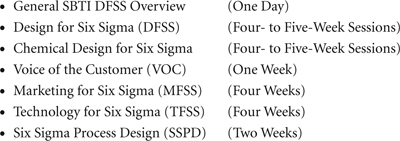
Chemical Design for Six Sigma—Black Belt Training
The first training overview we’ll review will be the Chemical Design for Six Sigma (CDFSS) Black Belt program targeting chemical processes and designs. This is an extensive training program consisting of five one-week sessions. The three topic categories include modules on technical design, new product gate review process, and the business of developing new products. Project reviews for each student are completed each week by a team of Project Champions. Each student arrives at the class with a chartered project in hand.
• Week 1
• Champion/Project Reviews
• CDFSS Roadmap and Vision
• Space Tower
• Stage Gate Process
• Understanding Customer Value
• Concept Engineering
• Market Segmentation
• Business Planning
• QFD and C&E Matrix
• Concept Selection
• Project Selection/Business Planning
• Project Management: Principles
• Product Stewardship/HSE&R
• Product/Process Development Roadmap
• Mapping/C&E Matrix
• Minitab
• Week 2
• Champion /Project Reviews
• Design FMEA/Process FMEA
• Design for Manufacture
• Defining Statistical Tolerances
• Capability
• Measurement Systems Analysis
• Presentation Basics
• Multi-Vari Studies
• Correlation
• Manufacturing Cost Estimation
• Teaming Skills
• Project Management: Project Mapping
• Week 3
• Champion/Project Reviews
• Design FMEA
• Modular Design
• Inferential Statistics
• Design of Experiments
• Multiple Regression
• Capital Cost Estimation
• Advanced Statistics
• Single Factor Experiments
• Project Management: Software
• Full Factorials
• 2K Factorials
• Week 4
• Champion/Project Reviews
• Experiments and Design Tolerances
• Robust Design Techniques
• Design Optimization
• Financial Analysis
• Fractional Factorial Experiments
• Advanced Measurement Systems
• Gate Reviews
• Week 5
• Champion/Project Reviews
• CDFSS Roadmap and Metrics
• Reliability Prediction
• Design and Process Validation
• Control Methods
• Documentation
• Hand-Off Procedures
• Mixtures/Formulations
• Multiple Regression
• Proprietary Positioning
• Creativity and Brainstorming
• Product Launch
• Maintenance and Reliability in Design
• Process Modeling and Simulation/Advanced Process Control
• Robust Design/DFM
• Scale-Up/Dimensional Analysis
• Control Plans
Operational Black Belt—Manufacturing Process Improvement
The next training overview we’ll discuss is the Operational Black Belt program targeting manufacturing processes and designs. This is an extensive training program consisting of four one-week sessions. The three topic categories include modules on technical process improvement, effective presentation skills, and team skills. Project reviews for each student are completed each week by a team of Project Champions. Each student arrives at the class with a chartered project in hand.
• Champions/Project Review
• Introduction to Six Sigma
• Project Chartering
• Process Mapping
• Cause and Effects Matrix
• FMEA
• Introduction to Minitab/JMP
• Basic Statistics
• Basic Quality Tools
• Measurement Systems Studies
• Capability Studies
• Multi-Vari Planning
• Sampling Considerations
• Team Formation
• Introduction to Control Plans
• Introduction to SPC
• Week Two
• Champions/Project Review
• Multi-Vari Analysis
• Confidence Intervals
• Central Limit Theorem
• Hypothesis Testing
• T-Tests
• One-Way ANOVA
• Chi-Square
• Correlation-Regression
• Introduction to DOE
• Helicopter Competition
• Week 2 Review and Action Planning
• Champions/Project Review
• Full Fractional DOE
• Fractional Factorial DOE
• Center Points and Blocking
• EVOP
• DOE Planning
• Capability II
• Multi-Vari II
• Multiple Regression
• Logistic Regression
• Summary
• Week Four
• Champions/Project Review
• Attribute Response DOE
• Autocorrelation
• Advanced Designs
• Statistical Control Methods
• Control Plans
• Sequential Experiments
• Sample Size Calculation
• Response Surface Methods
K-Sigma Black Belt (Six Sigma and Lean)—Manufacturing Process Improvement
The next training overview we’ll review will be the K-Sigma Black Belt program targeting manufacturing processes and designs. The K stands for “Kaizen” and represents Lean Enterprise technology. This is an extensive training program consisting of five one-week sessions. This Black Belt course is longer than the traditional Black Belt course because it includes training modules in both Six Sigma and Lean.
The three topic categories include modules on technical process improvement for both Six Sigma and Lean, effective presentation skills, and leading Kaizen events. Project reviews for each student are completed each week by a team of Project Champions. Each student arrives at the class with a chartered project in hand.
• Week One
• K-Sigma Overview
• Card Drop Experiment
• Roadmap Introduction
• Project Definition
• Identify Processes
• Voice of the Customer/Business
• Identify Metrics and Entitlement—Product Velocity, WIP, Cycle Time, Turns, Throughput, Delay Ratios
• Identify Constraints
• Problem Statement
• Leadership and Financial Approval
• Project Chartering
• Process Mapping
• Value Stream Mapping
• Variables Mapping
• Swim Lane Mapping
• SIPOC
• Handoff
• Spaghetti Maps
• Time Value Chart
• Current State Assessments
• Value/Non-Value Added
• People, Processes, Products, Materials
• C&E—First Level, Steps Only
• Project Management
• Change Management
• Implementation Plan
• How to Run a “Special K” Mini-Discovery Kaizen Event
• Deliverables for Session 2
• Week Two
• Black Belt Presentation of Session 1 Deliverables
• C&E Second Level, Variables
• Intro to Minitab or JMP
• Basic Stats and Graphs
• Trend Charts
• Time Series
• SPC (I-MR, Xbar-R)
• Develop Measurement Systems
• Analyze a Measurement System
• Data Validity
• Continuous MSA
• Attribute MSA
• Sampling I
• Systematic, Simple Random, Sub-Group
• Process Performance
• Voice of the Customer II
• Overall Equipment Effectiveness
• Capability (DPU, DPMO)
• Capability (Cp, Cpk, Pp, Ppk)
• Versus Takt
• Deliverables for Session 3
• Week Three
• Project Charter Update
• Quantify Entitlement
• Demand Segmentation, Demand Profile
• Multi-Cycle Analysis and Multi-Vari
• Analysis Methods (Hypothesis Testing, ANOVA, Chi2, Regression)
• FMEA
• Flow Analysis
• Little’s Law, Delay Ratios
• Application of Previous Tools to Analysis
• Spaghetti, Time Value, Takt
• Proper Kaizen—Introduction and Preliminary Preparation
• Week Four
• Presentation: Analysis Results
• Multi-Vari 2
• Analysis of Data Set and Multi-Cycle Analysis
• PRODSim™ Experiment
• Pull Systems
• Cellular Design
• Monument Management
• SMED
• Race Car Experiment
• Product and Process Family
• Simulation (Flow Charter, iGrafx)
• DOE (2k, 2k-n,. . .)
• EVOP
• Visual Workplace
• SOP
• Standard Work
• Line Balancing
• Poke-Yoke
• TPM
• Kaizen (Proper)
• Kaizen: Lock and Load
• Finalize Kaizen Plan
• Feasibility Study
• (Cost versus Benefit Analysis of Planned Improvements)
• Implementation Planning
• Benefits
• Owners
• Action
• Timing
• Week Five
• Kaizen Event Presentations
• Design the Implementation Plan
• Build a Process Control Plan
• SOP and Standard Work
• SPC
• Long Form FMEA
• Visual Management
• Dashboards
• GO Meetings
• Training/Skills Development
• Operations Management
• Roles and Responsibilities
• Self-Directed Team Creation
• CI Suggestion Process
• Balanced Scorecard
• Audit Planning
• Control Plan
• Plan versus Actual Measures/Performances
• Cost versus Benefit
• Assessment for the Next Cycle of Improvement
• Next Projects
Six Sigma “Belt” Training Summary
This is a quick overview of the three training programs that are designed to empower action and produce tangible results from Six Sigma. These are all traditional formats, but Six Sigma and Lean can be totally customized and should be customized for each company. For example, we have held Black Belt training for seven straight weeks instead of one week per month for four months. This format immerses the students in their projects and the class posts financial results within 10 weeks instead of the usual 4 to 6 months. This format will work for a relatively small proportion of businesses.
• Black Belt

• Green Belt

• Master Black Belt
• Prescriptive: 1- to 2-year development period.
• Student Evaluations
• All events are evaluated on both instructional quality and deployment quality.
• Feedback is provided within one week of each event.
Internalization of Training
Because of the complex nature of Six Sigma, most companies rely on external consulting groups to kick start the first year or two of the deployments. The goal is to transfer the Six Sigma training skills from the consulting company to the host company as quickly as possible. As soon as a company can say goodbye to the consultants and are able to complete the training with their own resources, the company has internalized Six Sigma. So, training the trainer is always part of a deployment plan. Your Black Belts, with the right development, can train future Green Belts.
The critical milestone on a deployment plan is a Master Black Belt training and development plan. Master Black Belts provide the technical consulting for Six Sigma instead of external consultants. The following is a sketch of a typical Master Black Belt development plan. The first section addresses the role of the Master Black Belts. The second section summarizes the development and training of a Master Black Belt.
The Master Black Belt
• These are the in-house technical experts, skilled in all facets of Lean Six Sigma:
• Statistical and Lean tools
• Project management
• Change leadership
• Teamwork
• Control systems
• The MBB
• Generates revenue: Coach and support Black Belts for results.
• Develops and delivers Six Sigma training.
• Assists in project identification.
• Partners with Six Sigma Champions.
• Identifies and deploys best practices.
• Potential MBBs rise from the ranks of the BBs who demonstrate strong skills, results orientation, and passion for the tools.
Master Black Belt Training Overview
• Master Black Belt candidates are chosen based on
• Demonstrated ability in achieving results.
• Interest in driving the Six Sigma program deployment.
• Certified Black Belt.
• MBB development program is tailored to needs of candidate and company, and generally contains
• Assignment of a mentor.
• Additional (off-site) training:
• Statistical methods.
• Leadership.
• Other soft skills.
• Setting of specific goals for contributing to the success of the program.
• 12–24 month process, depending on capability and prior experience of candidate.
• MBBs act in this capacity for 1–2 years.
The development of a Master Black Belt is relatively lengthy but when considered as a great leadership development program, the time spent developing Master Black Belts has a good ROI. The development process contains a rigorous certification process and a career path for MBBs. The MBBs should function as a corporate high-performance team that drives the development and delivery of the corporate Six Sigma training plan.
Training Plans
Training Plan Management. Each division and business in the company should develop training plans. I recommend the businesses include their Six Sigma training plan in the annual operation plan as a requirement. The Executive, Champion, Black Belt, and Green Belt training sessions will be included in this plan. The training courses are customized, linked to strategy, and uniquely designed to ensure that key players are properly equipped to understand and execute their roles and responsibilities. Results won’t happen unless effective training happens.
Training plans should be embedded in each person’s personal development plan. Training plans should also be developed for continuing education of successful Black Belts and Green Belts. Continuing education will address additional training in advanced tools and train-the-trainer for training other Belts or peers in the Six Sigma tools. Career advancement plans are developed and directed at Master Black Belt and Black Belt positions.
How Many Do You Train? The question of the number of Belts to be training occurs before the Six Sigma deployment. Figure 11.1 shows the number of Black Belts and Green Belts who were training during the first two years of the Six Sigma deployments for both AlliedSignal and General Electric. Fewer than 2 percent within both companies were trained as Black Belts. Because both AlliedSignal and GE focused on manufacturing operations, the proportion trained as Black Belts may be greater for companies that launch Six Sigma into Operations, Transactions, and Product Development simultaneously.
There was a radical difference in the number of Green Belts that both companies trained in two years. AlliedSignal trained less than 13 percent of their population as Green Belts and GE trained about 27 percent. Why the difference? Jack Welch dictated that every manager should be a Green Belt. That boosted the training numbers but did not radically affect the results.
Both companies brought about $880,000,000 of savings to the bottom line. AlliedSignal easily matched GE’s results while training only 3 percent of the number that GE trained. AlliedSignal averaged about $107,000 per trained Belt and GE averaged about $14,000 per trained Belt.
This demonstrated the risk of deploying Six Sigma to a training program rather than focusing on executing high-impact projects with Belt team leaders. I suspect that the executives at GE who were trained as Green Belts didn’t complete high-impact projects. But, at the end of the day, I would rather get $880,000,000 using only 8,000 Belts than $875,000 using a huge number of 64,000 trained Belts. Let the process of selecting high-impact projects define the work of Six Sigma Black or Green Belts.
Table 11.2 shows some recommended population percentages based on many other Six Sigma companies. Notice that product design groups have a higher recommendation for people trained. The feeling is that, because product design is the most complex business process technically, more people should be certified Black Belts and every design team member should be a Green Belt.
Table 11.1 Based on Annual Reports, the Number of Black Belts and Green Belts Trained in the First Two Years of the Six Sigma Deployment for AlliedSignal and General Electric

• Black Belts

• Green Belts

Table 11.2 shows a draft of a predeployment training plan covering the first 18 months. It includes leadership, Belt training, and Master Black Belt development. The results reported at the end of the year should match the execution of the training plan. If the training plan is missed, the results will be less.
Table 11.2 An Example of a Six Sigma Training Plan*
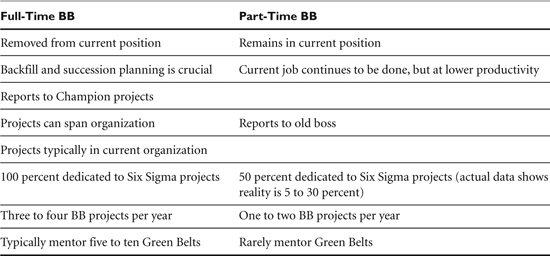
*This depicts the first 18 months of the Six Sigma deployment.
Dedicating Time. It’s not enough to train a huge number of people like GE did. You must have an infrastructure set to ensure that the trained people do enough to get certified. You also get more ROI if each of your trained people complete several projects over a year. They can’t do that part time. Here is my recommendation for dedicating time to your Six Sigma team:
• Dedicated time to training and project work yields success.
• Project time:
• The more time dedicated to a project yields higher returns in a shorter period of time.
• NOTE: This has been shown in benchmark data from corporations already involved in similar programs.
• Benchmark companies:
• Champions: half hour per week per BB
• Master Black Belts: 100 percent
• Black Belts: 70 to 100 percent time
• Green Belts: 20 to 50 percent of their time
Simply, the more projects completed, the better the results. Also, the more time dedicated to project work, the more projects are completed. If your project selection process identifies great projects, you would be shooting yourself in the foot by having a bunch of part-time Belts running around. A full-time Black Belt should be able to complete four or more projects per year. Each Black Belt should be worth $1,000,000 of savings per year if deployed aggressively. This is a great way to develop your future leaders.
Student Evaluations. The final section on training addresses student evaluations. Student evaluations are as much a part of the Six Sigma infrastructure as anything else. The Six Sigma Steering Team requires evidence that the quality of training is high and consistent. Feedback from the evaluations leads to courseware modification that fits the company.
The student evaluations provide performance data on your instructors and also provide great information about the progress of your deployment. The student evaluation has two components: (1) the quality of the training and (2) the quality of the deployment. The following is an example of a student evaluation.
You will see there are three sections to this evaluation. The first section assesses the instructional quality of the course itself (Items 1–20). The second section allows the students to rate their perception of the usefulness of the tools taught to them. And, the third section addresses how things are going for each student from the deployment standpoint. Is their Champion supporting their efforts? What percentage of their time are they spending on their project? And, are they getting frequent project reviews?
Black Belt Course Evaluation—Week 4
